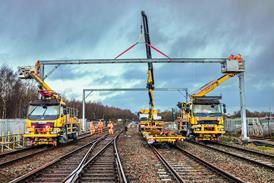At what point does a speculative joint venture become the exploitation of the naive or the desperate? Here’s an engineer’s take on this increasingly pressing question
Many aspects of running a consultant in today’s building industry seem more akin to those faced when running a contractor. The need to tender the lowest price to win work is just one of many examples that illustrate the fundamental change that has taken place, encouraged perhaps by the Thatcherite market approach that nobody in business is to be trusted. Some would argue that such an approach is a good thing, but I suspect that many structural engineering designers – and others, I’m sure – still struggle with that change, and maybe it is right that we do.
I was reminded of this struggle recently by a request from a contractor. Would we be interested in working “at risk” to help prepare a design-and-build tender? I gave it some thought. It would be an interesting project of reasonable size with a tender list of six. Working at risk is part of the commercial world now, so I confirmed that we were keen.
“You’ll be in competition on this one,” the contractor mentioned. I understand that, I mistakenly thought, that’s all part of working at risk, isn’t it? One of my colleagues then met the contractor, looked at the tender documents and established what was needed from us pre-tender. We also assessed what fee we would require if our client won. “Oh, no need for that until a couple of days before the tender is due in,” we were told. Only then did I start adding two and two and when I finally reached four, I phoned the contractor.
“So you want us work at risk but then we may not be in your team submitting the tender?”
I asked. “Yes, that’s right. We all work in a competitive world you know and there is only one other . We are doing the same with the architects.” Now it dawned on me that I should have multiplied two by six. Getting involved suddenly seemed decidedly less attractive. The odds had doubled, but a more fundamental problem was the uneven split of risk between the team members: I had a one in 12 chance of winning the work whereas the contractor had a one in six chance. It wasn’t to be a partnering contract, but surely there are some basic principles that should apply?
I sent my fee quote in, and its receipt was acknowledged, along with the news that my suggestion had gone down like a lead balloon. By then I realised I had better things to do back on Planet Earth …
“How about I send you a fee proposal tomorrow and you ask the other engineers to do the same?” I suggested. “You can then choose between us and save us both working at risk.” I was told the other engineers may not be able to come up with a fee that quickly – after all, they were busy working on the tender. I sent my fee quote in anyway and a couple of days later its receipt was acknowledged, along with the news that my suggestion had gone down like a lead balloon. I’m not sure by whom, but by then I realised I had more pressing things to do back on Planet Earth.
A couple of weeks later I was informed that the other engineer’s quote had been received and was 10% less than mine. They would therefore be chosen to go forward to the tender since, apart from the fee, “they have already done a significant amount of work at risk for us”. Yes, I thought, I think that was the point I was trying to make at the start.
I know it is accepted in our industry that huge amounts of work is carried out at risk on PFI and PPP projects, and we have been involved in a few. But the project that I’ve been telling you about will cost only a few million. I worry about the other engineer. Assuming it understood the situation, am I naive in asking why it went for it? Is this what happens to trade subcontractors as well? As for the architects … well perhaps in a culture that encourages “competitions”, the contractor’s proposal may not have seemed as out of order as I perceived it to be – although even in a competition the winner is supposed to get the job.
We will continue to work successfully with contractor clients on design-and-build projects. In many ways we find a well-run design-and-build project as satisfying as a traditionally procured one. We will continue to attempt to take a reasonably commercial approach and be prepared to work at risk when it makes sense to us but just how desperate did that contractor think we were? When you see the smiling face pictured above at the wheel of a minicab or pulling pints in your local, feel free to come up with such business proposals. Until then, let’s all show each other some Latham/Egan-style common sense and respect.
Postscript
Bob Stagg is a director at consulting structural engineer Alan Conisbee and Associates

























No comments yet